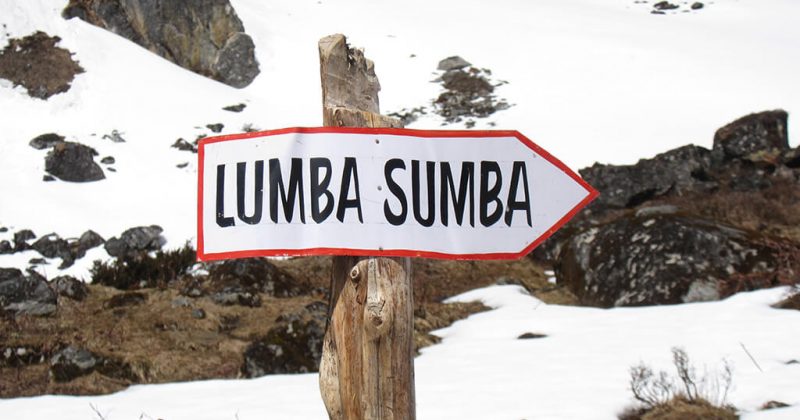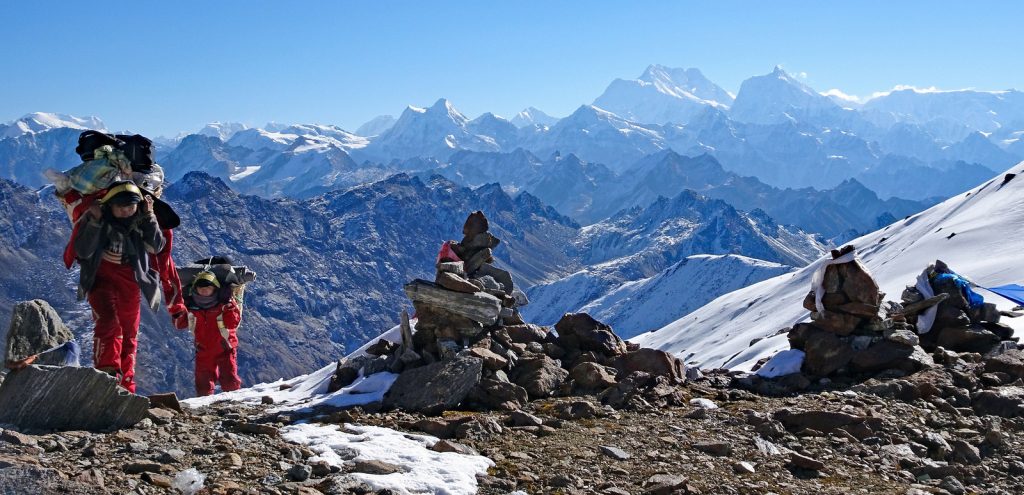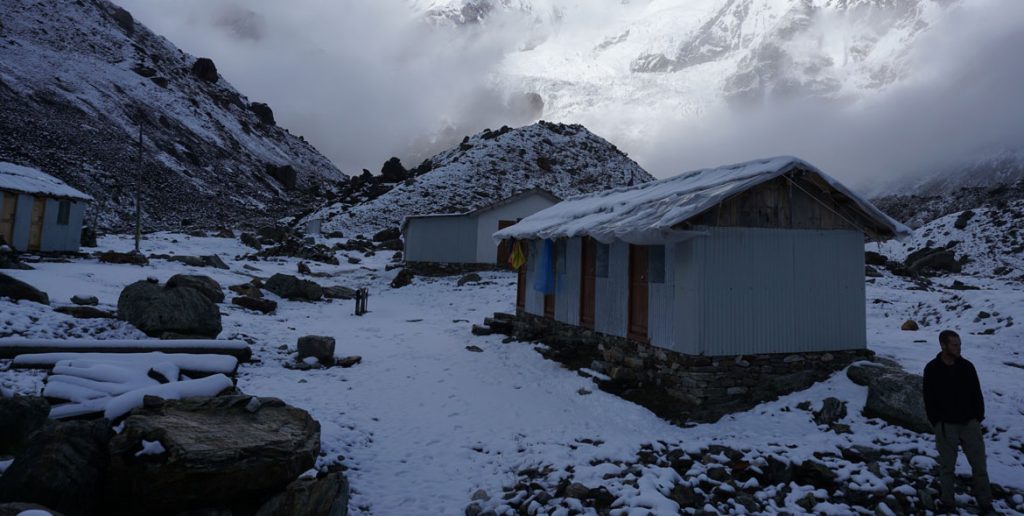Lumba Sumba Trekking is one of the most admiring and adventurous trekking in Nepal. You have to travel to the Eastern Nepal. This trek let you experience the lowlands to the terraced farmlands and culture and tradition of the Limbu ethnicities. Lumba Sumba trek traverses through one of the least frequented trails of eastern Nepal between two Himalayan giants, Kanchenjunga (8,586m) and Makalu (8,463m). This is a challenging trek where trekkers face extreme remoteness, high altitude and most importantly the fun of walking adventure. It initially treads the trails of Kanchenjunga Base Camp Trek until Phale Gaon. Beyond Phale Gaon the trek crosses Nango La Pass to Olangchung Gola and simultaneously goes over Lumba-Sumba Pass to the village of Thudam, where the trekkers can observe authentic cultures of Tibetan Buddhists and Bhotiyas.


Throughout the challenging trek, there are several rewards. Pleasant walk through the beautiful woods of colorful rhododendrons and diverse species of birds, the close views of Himalayan peaks in Kanchenjunga and Makalu Himalayan Ranges and great cultural encounters in the frequent traditional villages are rewards that would remain forever in the mind and soul of every trekker who has undertaken this Spring Special Trek. Lumba Sumba Trekking is one of the new trekking routes in the Eastern Himalayas. Lumba Sumba Peak (5,200m) is the major attraction of this route. Offering some of the most spectacular Himalayan landscapes, this trekking route is home to different ethnic groups like the Limbus, Sherpas, Rai, Gurung, Magars, Newars and Tamangs. Trekkers can explore the traditional farming practices and see different birds and wildlife species, including the endangered snow leopard and red panda, from the route. There are a number of high mountain lakes in Olangchung Gola.
Through this route, you will explore two of Nepal’s best preserved protected areas – the Kanchenjunga Conservation Area and the Makalu Barun National Park. Through the route, one can also trek to the base camps of Mt Kanchenjunga and Mt Makalu. Similarly, the Tamor and Arun River systems can be the other attraction for tourists. These two rivers are the major tributaries of the mighty Sapta Koshi River. The route encompasses alpine grasslands, rocky outcrops, dense temperate and sub-tropical forests, and low river valleys. Apart from natural beauty, trekkers can also explore cultural heritage like monasteries, chhortens, temples and prayer walls. And to add to the flavor, the festivals of all of these people living in harmony only serve to make the native culture livelier.
The journey starts with the flight from Kathmandu to Suketar. Flying to the far eastern airstrips nestled in a small mountainous town is itself a gripping adventure. After you land at the airport in Suketar, you will check into a teahouse or tourist and make the final arrangements for the upcoming trek.
Today you will trek to the drops down through the forested region to Mitlung. The trek begins through the streets of a small town. The first day of the trek stops at Aangshyan Patti for Lunch. Traversing through the villages like Handew and Panishar you will cross the bridge overHang Hangdewa Khola and get in Lumbagaon. Beyond Lumbagaon, you will trade along the trails beside Tamor Khola and arrive at Mitlung.
Today’s trek has a series of up and down climbs through the jungle and it crosses several small streams. Most of the climbs are gradual and you will have plenty to walk on pleasant leveled trails. Hiking along the trails inside rhododendron forest above Tamor River, you will arrive in Sinsegaon. Crossing the suspension bridge over Sinse Khola you will follow the forest trail to emerge at Sinwa, where you will have your lunch. Beyond Sinwa the trail begins to gain altitude gradually all the way up to Chirwa via culturally rich villages like Tawa and Thiwa.
Today you will have a relatively short trek compared to other days. Exiting out of Chirwa along the uphill trail through the village and crossing the landslide area, you will arrive at Dunge Khet. Beyond Dunge Khet you tread the main trail of Kanchenjunga Base Camp to Suketham via tribal villages like Phembu and Hellok.
This day you will take a climb through the uphill throughout the trek. You will have to cross the bridge over Ghunsa Khola before arriving at Amjisola. Amjisola has natural hot water springs, where you can release all the exhaustion.


Uphill walk through the Jungle of rhododendron, oaks and firs for four long hours brings you to Kyapra. Kyapra is a traditional tribal village of the region having a temple, monastery and long line chortens. Explore around the village and experience the authentic culture at Kaypra.
The trek today treads onwards the trail that goes to Namche of Kanchenjunga Trekking Route- Ghunsa. However, your destination is not up to Ghunsa. The first three and half hours of today’s trek winds through a jungle of pines, rhododendron and oaks to Phalegaon. Explore Tibetan Refugee Camp at Phalegaon and settle down to rest in your camps.
Today you will have a day rest at Phalegaon, so that you get prepared better for the upcoming challenges across Nango La and Lumba- Sumba Passes. However, one and half hours of gentle walk from Phalegaon brings you to Ghunsa. Experience the offbeat Namche at Ghunsa and trek back to Phalegaon.
You will experience the real trails of Lumba Sumba Circuit trek. You will walk through the forest of juniper. Crossing the bridge over Yangma Samba River, you will begin to trek uphill on the trail at the bank of the same river and to Kharka.
Today you will begin the trek with the uphill hike on a rocky trail to the top of Nango La Pass. The day is long and you will be treading along the snowy path down from Nango La Pass to Yangma Khola. Hence, careful walking is required. Later half of the trek closer towards Yangma Khola, you will walk through dense jungle and cross Langong Kharka.
Entire day’s trek traverses along the trail beside the bank of Yangma Khola until you will reach Ramite. It climbs up the times and at other times the trail remains level with the river. Beyond Ramite, Lumba Sumba Trek today arrives in a fascinating Tibetan village, Olangchun Gola, treading the trail beside Tamor River. The village aka the village of Wolf is the last village before the Tibetan border. Having sixty houses, Olangchun Gola is an authentic Tibetan Village. The village has 465 years old Dekhi Chholing Gompa. Explore around and enjoy your stay in Olangchun Gola.


You will walk gradually uphill through the forested trail that lies on the hills above Tamor River. The travelers have to cross the bridge over Tamor River at Langmale and continue to head up along the riverside trail to Yangetar.
The journey takes you to the Base Camp of Lumba Sumba along the rocky trails.
The final steps to the top of Lumba Sumba Pass is along the glacial moraines and snow covered path. It is the most challenging part of the entire trek and the meantime it also has the biggest rewards. From the top of Lumba- Sumba Pass you can see very close and excellent views of mountain peaks, which include Kanchenjunga, Jannu, Khambachen, Makalu, Hongku, Baruntse range and other many Himalayan peaks as well. Enjoy the moments at Lumba-Sumba Pass and slide down steeply to Yak Kharka.


Tread along the trail that stretches on the right bank of Lapsi Khola and arrive at Thudam. Thudam is a Bhotiya Village, who are the true descendents of Tibetans. You can witness very much authentic Tibetan culture at Thudam.
Today the trail drops down to Arun River. Trekking along the difficult and narrowed trails you will arrive to Chyamtang at the end of day’s trek.
From Chyamtang, you will trek slightly uphill to Guthi Gompa and then drop down to Lingam. Treading through the forested trails you wil emerge at Chepuwa and beyond Chepuwa once again you will enter the beautiful woods of rhododendrons and emerge out to Gimbar. You will have your lunch here. Beyond Gimbar, you will cross the bridge over a small stream and tread through the forested region to Hongon.
Today, the trek drops down sharply to Gola. Most of the time the trail traverses through the jungle and at other times it goes through the cultural villages like Hatiya and Barun Dovan.
The trail goes through a series of up and down, which are gradual. You will walk through forests and villages to Hedanga Gadi.
This is the last day of the trek, which is relatively shorter and easier. Arrive at Num, let your trek exhaustion go, enjoy with the crew and celebrate the success.
Today you will drive to Tumlingtar. 4-5 hours of bumpy ride on the mishmash mountainous road brings you to Tumlingtar, a small town having a small airport.
You will say goodbye to all the forests and mountains and take a flight from here to Kathmandu valley with all the good memories and experiences.
Shopping is my option in contrast to Red Bull. Regardless…


Hundreds of years of preservation and perseverance, nourished and timely…
Among the many 12 years festivals Nepal has, Lha Phewa…